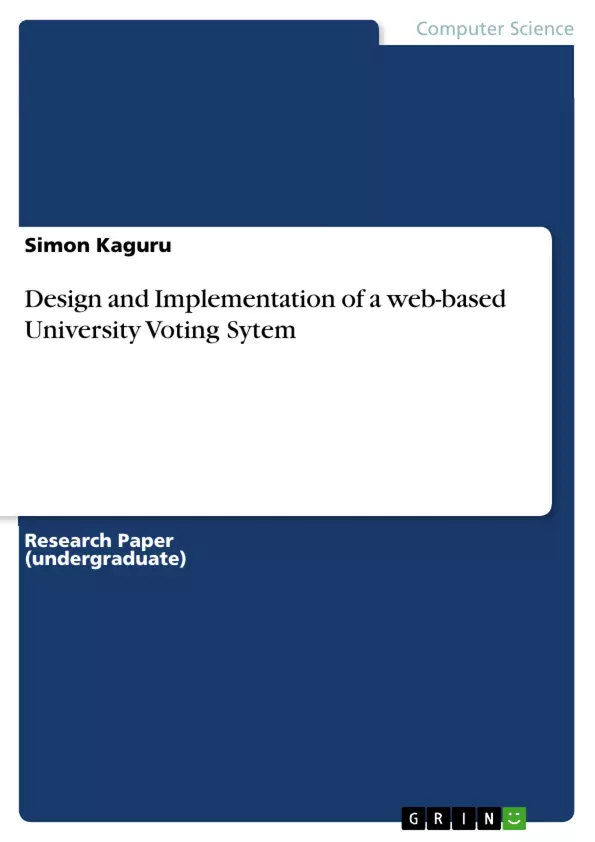An Online Voting System is a web based system that facilitates the running of elections online. Most higher learning institutions in Kenya conduct elections regularly in order to elect a student leadership to elect them. The elections conducted are mainly manual hence they are marred with irregularities which usually affect negatively the results of the election. In this era of advanced technology where online systems boosts work speed, reduces mistakes and promote the generation of accurate results, having a manual system like the paper-based version becomes a misfortune. An online system, which involves procedures like registration of voters, vote casting, vote counting, and declaring results etc. would constitute a good solution to replace current system that is in the universities in Kenya. Online systems have the advantage of providing convenience to the voter and reduce the time wasted in the queuing process at election centers and also promote security in the voting process.
This paper hence describes the UVS which is a web-based online voting system that helps facilitate voting on the internet by providing a platform students are provided with an online registration form which requires them to register as voters, and then the details filled on the form are submitted in the database which then approves the user who can then login into the UVS and cast their vote. The UVS was developed using the waterfall model due to the adaptive nature of web based applications and the system proved that a computerized solution is possible with elimination of human related faults that are a commonplace in employment of human clerks to manage the election process. This paper has proposed the basic structure of the system and its functionality which can be employed to replace the current electoral system used in Universities.
Inhaltsverzeichnis (Table of Contents)
- CHAPTER ONE
- INTRODUCTION
- 1.1 Background of the study
- 1.2 Problem Statement
- 1.3 Aim of the Project
- 1.4 Objectives of the project
- 1.5 Objectives of the system
- 1.6 Significance of the Project
- 1.7 Project Justification
- 1.8 Scope of Study
- 1.9 Limitation of Study
- CHAPTER TWO
- LITERATURE REVIEW
- 2.1 Introduction
- 2.2 Case Study: Easwari Engineering College Voting System
- 2.2.1 System Background
- 2.2.2 System Workaround
- 2.2.3 Product Functions
- 2.2.4 Overview of Data Requirements
- 2.2.5 Constraints
- 2.2.6 Features on the System
- CHAPTER THREE
- RESEARCH METHODOLOGY
- 3.1 Introduction
- 3.2 System Overview
- 3.3 System Analysis
- 3.3.1 Existing System
- 3.3.2 Limitations of the Existing System
- 3.3.3 Proposed System
- 3.4 System Requirements
- 3.4.1 Technologies
- 3.5 Hardware and Software Requirements
- 3.6 System Design
- 3.7 Database Design
- 3.7.1 Administrators
- 3.7.2 Candidates
- 3.7.3 Members
- 3.7.4 Positions
- 3.8 Database Entity-Relation (ER) Diagram
- 3.9 Data Flow Diagram
- 3.10 Use Case Diagram
- 3.11 Activity Diagrams
- 3.12 System Flow Chart
- Administration Control Panel
- Student Home
- CHAPTER FOUR
- TESTING AND RESULTS
- 4.1 Introduction
- 4.2 Form input and Reports Design
- 4.2.1 User/Voter Registration Form
Zielsetzung und Themenschwerpunkte (Objectives and Key Themes)
The research project "UNIVERSITY VOTING SYSTEM (UVS)" aims to develop a secure and efficient electronic voting system for university elections. The project aims to improve the existing voting system, address its limitations, and enhance the overall electoral process.
- Development of a user-friendly and secure electronic voting system.
- Analysis and evaluation of existing voting systems in universities.
- Exploration of the technical and logistical challenges associated with implementing a university-wide electronic voting system.
- Implementation of a robust and reliable database system to manage voter information and election results.
- Testing and evaluation of the developed system to ensure its accuracy, efficiency, and security.
Zusammenfassung der Kapitel (Chapter Summaries)
- Chapter One: Introduction - This chapter provides the context for the research, outlining the problem statement, aims, objectives, and significance of the study. It also discusses the scope and limitations of the project.
- Chapter Two: Literature Review - This chapter presents an overview of existing research and literature related to electronic voting systems, particularly in the context of universities. It also includes a case study of a similar system implemented at Easwari Engineering College.
- Chapter Three: Research Methodology - This chapter details the research methodology employed for the development of the UVS system. It includes a description of the system overview, system analysis, system requirements, hardware and software requirements, system design, database design, and various diagrams such as ER diagrams, data flow diagrams, use case diagrams, and activity diagrams.
- Chapter Four: Testing and Results - This chapter presents the testing and evaluation of the UVS system, including the design of user registration forms and reports.
Schlüsselwörter (Keywords)
The research focuses on the development and implementation of a secure and efficient electronic voting system (UVS) for university elections. Key concepts include system analysis, system design, database design, user interface design, testing, and evaluation. The project aims to address issues related to existing voting systems, such as security vulnerabilities and efficiency limitations. The study explores the use of technology to enhance the electoral process, improve voter participation, and ensure transparent and accurate election results.
- Citation du texte
- Simon Kaguru (Auteur), 2017, Design and Implementation of a web-based University Voting Sytem, Munich, GRIN Verlag, https://www.grin.com/document/387298



